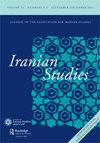波斯语在比德利斯及其周边地区的文化影响
IF 0.7
4区 社会学
Q2 AREA STUDIES
引用次数: 0
摘要
一开始,看到伊朗诗人Khayyām的鲁巴伊诗和其他波斯诗歌出现在19世纪末Bidlis的墓碑上,似乎令人费解。然而,当仔细审视比德利斯的政治和文化历史时,很明显,波斯语言和文化在这个城市有着深厚而悠久的根基,并在这两个方面融入了高度的伊朗-伊斯兰文化。主要基于原始档案资料和铭文,我触及了波斯语的冒险和优势——比德利斯统治者的通用语,一个位于奥斯曼-伊朗边境的库尔德公国——以及它的知识分子,在这座城市融入奥斯曼世界之后,因此波斯语的优势正在衰落。穆罕默德·阿明Riyāhī的书Nofūz-e zabān o adabīyāt-e Fārsī dar qalamrov-e Osmānī在这方面是一个著名的研究,但主要集中在波斯人在宫廷内外的冒险。另一本关于这一主题的综合性书籍《波斯世界:欧亚通用语的疆界》,说明了波斯语在从中国、中亚、印度到奥斯曼世界的广阔地理范围内使用的疆界。本文将重点放在一个有限的地区,如该地区最负盛名的公国比德利斯,试图阐明波斯语在奥斯曼-伊朗边境的影响,揭示其作为外交和文学语言的影响,以及在库尔德统治者统治的土地上比德利斯知识分子的通语。本文章由计算机程序翻译,如有差异,请以英文原文为准。
The Cultural Impact of the Persian Language in and around Bidlis
Abstract It may seem perplexing, in the beginning, to see Iranian poet Khayyām's rubaie s and other Persian poems on the gravestones of Bidlis from the late nineteenth century. However, when scrutinizing Bidlis's political and cultural history, it is clear that Persian language and culture has deep, longstanding roots in this city and been integrated into high Iranian-Islamic culture in both respects. Based mainly on primary archival sources and inscriptions, I touch on the adventures and preponderance of Persian—the lingua franca of the rulers of Bidlis, a Kurdish principality located on the Ottoman-Iranian frontier—and its intellectuals after the city was integrated into the Ottoman world, and thus the decaying ascendancy of Persian. Mohammad Amin Riyāhī's book, Nofūz-e zabān o adabīyāt-e Fārsī dar qalamrov-e Osmānī , is a well-known study in this respect, but mostly focuses on the adventures of Persian in and around court circles. Another comprehensive book on the subject, The Persianate World: The Frontiers of a Eurasian Lingua Franca , illustrates the frontiers of Persian's usage in the vast geography stretching from China, Central Asia, and India to the Ottoman world. By focusing on a limited area like Bidlis, the region's most prestigious principality, this article attempts to elucidate the impact of Persian in the Ottoman-Iranian frontiers, unearthing its influence as a language of both diplomacy and literature as well as a lingua franca of Bidlis intellectuals in the lands ruled by Kurdish rulers.
求助全文
通过发布文献求助,成功后即可免费获取论文全文。
去求助
来源期刊

Iranian Studies
Multiple-
自引率
0.00%
发文量
92
期刊介绍:
Iranian Studies is a peer-reviewed journal devoted to Iranian and Persian history, literature, and society, published on behalf of the Association for Iranian Studies . Its scope includes all areas of the world with a Persian or Iranian legacy, especially Iran, Afghanistan, Central Asia and the Caucasus, and northern India, and Iranians in the diaspora. It welcomes submissions in all disciplines.
 求助内容:
求助内容: 应助结果提醒方式:
应助结果提醒方式:


